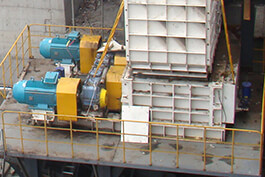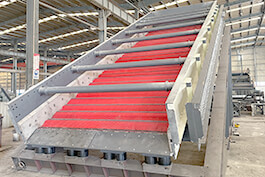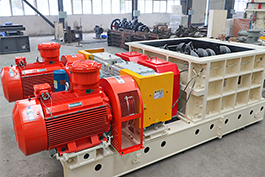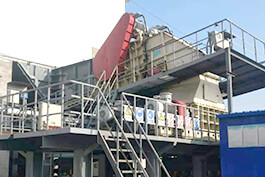Introduction
The pans of the Apron Feeder are required to operate under harsh conditions such as heavy loads, impacts, wear and possible corrosion. Therefore, the selection of the material for the chain plates is a very crucial technical decision that directly affects the lifespan, performance and cost of the Apron Feeder.
Common Chain Plate Materials and Their Characteristics
Carbon Structural Steel
Strength
For example, Q235 series, the yield strength is 235 MPa, which can meet the load requirements for general material transportation, but compared to high-strength low-alloy structural steel, the bearing capacity is slightly weaker.
Toughness
It has certain toughness at room temperature, but in low-temperature environments or when subjected to large impacts, the risk of brittle fracture is relatively higher.
Forgeability
It has good forgeability, which is convenient for processing, manufacturing, and daily maintenance.
Wear Resistance
The hardness is relatively low, and the wear resistance is poor. It is not suitable for transporting materials with high abrasiveness.
Economy
The price is relatively low, and the cost advantage is obvious.
Application Scenarios
It is only used for small-sized, lightly loaded, and materials with extremely low abrasiveness Apron Feeder, such as transporting materials with low density like wood chips and grains. It is not recommended to be used as the main load-bearing chain plate in the heavy industry.
.jpg)
High-strength low-alloy structural steel
Strength
Such as Q355B/Q345B, yield strength 355 MPa, capable of withstanding huge material loads and chain tension, achieving the unity of lightweight and high strength.
Ductility
Can maintain good impact toughness above 0℃, preventing brittle fracture.
Weldability
Easy to manufacture and maintain, convenient for adding reinforcing ribs and performing overlay welding repairs.
Wear resistance
Its own hardness is sufficient to handle medium abrasive materials.
Economy
Moderate price, extremely high cost-effectiveness.
Application scenarios
Suitable for heavy-duty apron feeders, capable of transporting medium abrasive and load-bearing materials such as ores, coal, and sand and gravel, widely used in mining, metallurgy, and construction industries.
High-strength wear-resistant steel
Characteristics
Such as NM360, NM400, NM450, HARDOX series, has extremely high hardness (HB) and tensile strength, and its wear resistance is several times that of ordinary steel plates.
Advantages
Extremely wear-resistant, significantly extending the service life in high-maintenance conditions.
Disadvantages
High cost: The price is much higher than Q355B.
Poor weldability
High carbon content, during welding, strict preheating and control processes are required; otherwise, cracks are prone to occur.
Relatively low toughness
More sensitive to impact loads, when subjected to the impact of large pieces of materials, cracks may occur.
Application scenarios
For transporting extremely abrasive materials, such as iron ore, granite, scrap steel, slag, etc. It is usually not used to manufacture the entire apron feeder chain plate, but is used as a wear-resistant liner plate embedded in the high-maintenance area of the Q355B base plate.
Reason for using Q355B as the material for the apron feeder chain
Mechanical properties
High strength
Q355B is a low-alloy high-strength structural steel. The "355" indicates that its yield strength is not less than 355 MPa. This is much higher than that of ordinary carbon structural steel (such as Q235, with a yield strength of 235 MPa).
Significance for Apron Feeder
The chain plate of Apron Feeder needs to withstand huge loads, including:
The weight of materials: Especially for large feeders, the materials they carry can reach tens or even hundreds of tons.
The tension of the chain: The huge tension transmitted by the drive sprocket through the chain.
Impact load: The impact from large, heavy materials (such as ores, limestone, etc.) falling from the upper silo.
Using Q355B can provide sufficient structural strength and carrying capacity without significantly increasing the plate thickness, achieving the unity of lightweight and high strength.
Good toughness
The letter "B" after Q355B indicates that it has qualified impact toughness above 0°C.
Significance for Apron Feeder
The equipment will be subjected to vibration and impact during operation. Good toughness can prevent the chain plate from brittle fracture in low-temperature environments or sudden impacts, ensuring the safety and reliability of the equipment.
Weldability and processability
The chain plates of the Apron Feeder are usually not a single piece of steel plate, but a complex structural component formed by welding components such as panels, reinforcing ribs, and chain joint seats. The carbon equivalent of Q355B is relatively low, and it has good welding performance, with a lower tendency to produce cracks during welding.
This makes the manufacturing process more convenient and reliable, and ensures the quality of the welded joints, which is crucial for components that bear heavy loads and impacts.
Durability
The hardness of Q355B is sufficient to handle medium abrasive materials. During the operation of the Apron Feeder, the materials will constantly rub against the surface of the chain plate. If the chain plate has poor wear resistance, it will wear out quickly, resulting in a reduction in the thickness and strength of the chain plate, which in turn affects the normal operation and service life of the equipment.
However, the wear resistance of Q355B can ensure that the chain plate maintains a good surface condition and structural integrity during the transportation of medium abrasive materials for a certain period of time, reducing the frequency of chain plate replacement due to wear and lowering the maintenance cost and downtime of the equipment.
Economy
From a cost perspective, the price of Q355B is moderate. Compared to common carbon structural steels such as Q235, although its price is slightly higher, considering its higher strength, toughness, and wear resistance and other comprehensive properties, it can provide a longer service life and more stable operation for apron feeders. In terms of long-term usage cost, it has a higher cost-effectiveness.
In contrast, compared to high-strength wear-resistant steels such as NM360 and NM400, the price of Q355B is much lower. Although high-strength wear-resistant steels have excellent wear resistance, they are costly, have poor weldability, and relatively lower toughness.
Conclusion
In the selection of apron feeder pan materials, Q355B low-alloy high-strength structural steel has high strength, which can meet the heavy-load bearing requirements of the chain plate and ensure the stable operation of the equipment; its wear resistance is moderate, which can handle medium abrasive materials for transportation, reducing maintenance costs and downtime.


.jpg)



.jpg)






